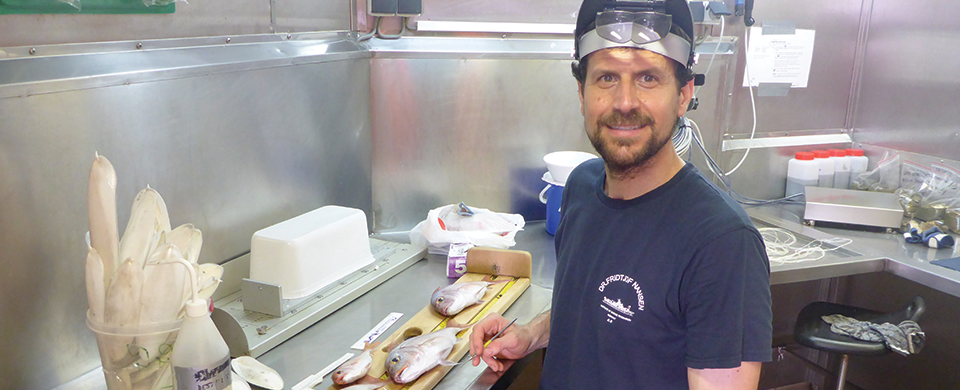Advancing biodiversity research with discovery of new fish species in Myanmar

* Access FAO Story here
22 May 2023, World Biodiversity Day – Scientists estimate around 8.7 million species on the planet have yet to be identified. So, when researchers on the research vessel (R/V) Dr. Fridtjof Nansen discovered new species in the Indian Ocean, the news was significant.
Among them were two new perchlet species of the genus Chelidoperca and two new sandlances of the genus Bleekeria during surveys conducted in 2015 and 2018 by the research vessel, R/V Dr. Fridtjof Nansen off the coast of Myanmar.
They are among the 23 new species discovered in Myanmar waters during the surveys organized by the Nansen Programme, which also provided training for local scientists who participated in the research and data collection.
"We have 23 new fish species formally described to date," says Peter Psomadakis, FAO taxonomist. "There are also other potential new species collected in Myanmar, but it's going to take some time to confirm that because they have to go through a process of validation by international experts."
Correct species identification is important for protecting our endangered biodiversity. However, some coastal countries in Africa and Asia lack the necessary human and financial resources for effective biodiversity and ecosystem monitoring.
This is where the EAF-Nansen Programme, a partnership between FAO and the Norwegian Agency for Development Cooperation (Norad), Norway’s Institute of Marine Research (IMR), and 32 partner countries in Africa and the Bay of Bengal, is making a substantial difference to scientific research and capacity building.
The EAF-Nansen Programme draws on more than 45 years of scientific expertise and collaboration with the deployment of the research vessel, the R/V Dr. Fridtjof Nansen, which is named after the late Norwegian scientist, polar explorer and humanitarian who pioneered ocean research.
From an ecological perspective, the ecosystem approach to fisheries calls for a holistic understanding of resources, habitats and environment. “In Myanmar, great attention has been devoted to studying biodiversity and habitats and trying to establish the biodiversity baseline,” says Psomadakis.
"Biodiversity baselines act as a reference for comparing changes in species composition over time, so that decision makers can identify threats to species and habitats and design actions to manage these impacts. So, this is a milestone for biodiversity research in Myanmar."
One of the new species, Chelidoperca myathantuni was named after Mya Than Tun, former director of research and development in Myanmar’s Department of Fisheries in recognition of his contribution to improving knowledge about fisheries resources and ichthyology in his country.
Mya Than Tun participated in the 2013 Nansen survey and acted as assistant trainer during the 2018 taxonomy course organized by the Programme in Yangon. He also wrote a book on marine fish species found in Myanmar and co-authored the FAO Field Guide to the Living Marine Resources of Myanmar published in 2019.
The FAO Myanmar guide was based almost entirely on field data collected from the Nansen Myanmar surveys in addition to data collected by Mya Than Tun and his team at different landing sites along Myanmar’s coastline.
Taxonomy courses raise research capacity and data quality from Nansen surveys
Psomadakis leads the EAF-Nansen’s taxonomy courses at both the regional and national level. He ran training courses for the Myanmar scientists and others from the region, before they participated in the two surveys conducted aboard the vessel.
"The aim of these taxonomy courses is to strengthen the capacity of scientists from partner countries to identify species correctly and also elevate the quality of the data collected on board. The training courses are usually conducted in anticipation of the surveys," says Psomadakis.
The Programme has gone a step forward and recently launched Taxonomy Research Workshops aimed at elevating the capacity of scientists from partner countries to carry out taxonomy research and produce scientific output as lead authors.
More than 800 specimens and associated tissue samples were obtained during the Nansen surveys in Myanmar and are stored at the South African Institute for Aquatic Biodiversity (SAIAB), one of the world’s largest collections of Indian Ocean fish, housing about 650,000 fish specimens.
Merete Tandstad, Co-Ordinator of the EAF-Nansen Programme, says: "The Myanmar surveys will be remembered for the extraordinary number of newly discovered species, not only in the history of the Nansen Programme but also by the international scientific community as being among the most productive surveys in terms of newly identified fish species."
"These findings highlight the value of surveys at sea for increasing our understanding of marine biodiversity while providing coastal states with important knowledge for the sustainable management of their fisheries resources."
Taxonomy is recognized as the foundation that underpins our knowledge of biodiversity. As climate change, overfishing, pollution and other factors are having a growing impact on our marine ecosystems, robust data collection and validation are essential for informed decision-making for the sustainable use of resources and conservation of our oceans' biodiversity.
More information on the topic:
- Survey results on the fishery resources and marine ecosystems of Myanmar
- Field identification guide to the living marine resources of Myanmar
- The Nansen Research Vessel surveys in coastal areas of Myanmar
- Fishery and oceanographic research vessel the R/V Dr Fridtjof Nansen (FAO Myanmar)
